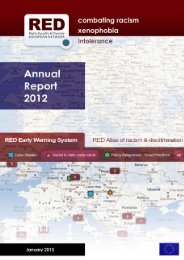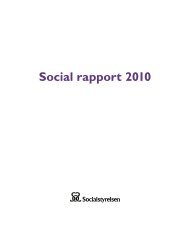R26PITFALLS AND BIAS2008, 136). Ardila (2005) describes ways that testing procedures <strong>and</strong> conditions might conflict with children’shome communities. For example, tests are administered through a highly regimented script with specific instructions<strong>and</strong> formal language which might be difficult for some children who might not have had access to educationalsettings where formal instructions are usually given. For collective cultures, dem<strong>and</strong>s for individual responses orrequests to “do your best” might not be as valued as in <strong>the</strong> dominant culture. In addition, certain tasks that arepart <strong>of</strong> intelligence tests, such as figure drawing or digit repetition might seem purposeless <strong>and</strong> unimportant. Some<strong>of</strong> <strong>the</strong> items on intelligence tests are timed or depend on a child’s processing “speed.” Time can be considereda social construct, <strong>and</strong> for some cultural groups, tests that are timed or depend on speed are inappropriate, as itmight take a slow <strong>and</strong> deliberative process to carefully work through test items <strong>and</strong> produce quality work.Individuals who administer <strong>the</strong> tests are usually strangers to those to whom <strong>the</strong>y give <strong>the</strong> test, which also mightimpact a child’s performance on <strong>the</strong> test. Moreover, for some children it might be strange for an adult to askquestions to which <strong>the</strong>y (that is, as <strong>the</strong> adults) should already know <strong>the</strong> answer. Therefore, it is essential thatassessments consider <strong>the</strong> language <strong>and</strong> cultural characteristics <strong>of</strong> <strong>the</strong> children being tested both during testadministration <strong>and</strong> when interpreting <strong>the</strong> results <strong>of</strong> <strong>the</strong> test (Center on <strong>the</strong> Developing Child 2007, 22).Dynamic testing is a strategy that might be useful to consider when administering intelligence or ability teststo children from minority communities. Whereas st<strong>and</strong>ard assessment practices focus on stasis, evaluatingpreexisting, pre-learned skills, dynamic assessment emphasizes measuring <strong>the</strong> processes involved in learning <strong>and</strong>change (Sternberg et al. 2002, 143). In a study <strong>of</strong> <strong>the</strong> assessment <strong>of</strong> intellectual potential in rural Tanzanianschool children, Sternberg <strong>and</strong> colleagues (2002) sought to determine if short intervention teaching <strong>of</strong> cognitiveskills <strong>and</strong> strategies would have any effect on posttest scores, in essence, to assess developing abilities. All childrenwere given a pretest, <strong>and</strong> <strong>the</strong>n <strong>the</strong> experimental group <strong>of</strong> children received short intervention teaching sessionswhile <strong>the</strong> control group received no such interventions. All children were administered a posttest. The posttestscores <strong>of</strong> children who received short intervention teaching increased compared with children in <strong>the</strong> controlgroup. Dynamic testing by its nature contributes to a less neutral relationship between <strong>the</strong> examiner <strong>and</strong> examineethan in traditional, static testing situations. The dynamic testing procedure seems to tap into “important abilitiesthat would not have been measured were one only to have considered <strong>the</strong> pretest (static) scores” (Sternberg etal. 2002, 158). In discussing differences between static (traditional) <strong>and</strong> dynamic testing, Sternberg <strong>and</strong> colleaguesnote that <strong>the</strong> intervention teaching sessions were short, lasting less than an hour. In dynamic testing, childrenare provided feedback until <strong>the</strong>y ei<strong>the</strong>r solve a problem or give up. In this way, testing “joins with instruction, <strong>and</strong><strong>the</strong> test-taker’s ability to learn is quantified while he or she learns” (Sternberg et al. 2002, 143). Through thismethod <strong>of</strong> testing, children are able to show <strong>the</strong>ir knowledge through a brief intervention whereby children learn<strong>the</strong> nuances <strong>of</strong> test-taking, something <strong>the</strong>y might not have had exposure to in <strong>the</strong> past.
R27Language biasCulture <strong>and</strong> language are <strong>of</strong>ten interrelated, but <strong>the</strong>re are specific concerns regarding language acquisition whenadministering, interpreting, <strong>and</strong> scoring assessments. For children for whom <strong>the</strong> dominant language <strong>of</strong> a countryor region is not <strong>the</strong>ir home language, pr<strong>of</strong>iciency in <strong>the</strong> dominant language is acquired through exposure to <strong>the</strong>dominant language, typically through school experiences. Flowing from this, <strong>the</strong> language <strong>of</strong> school entry <strong>and</strong>intelligence tests is acquired through exposure (Oller 1997, 475). Oller (1997) also argues that language is a primaryfactor in IQ variance due to differences in <strong>the</strong> language <strong>and</strong> dialects used by examiners, differences in <strong>the</strong> accessibility<strong>of</strong> <strong>the</strong> language <strong>and</strong> dialects to <strong>the</strong> individuals being tested, <strong>and</strong> <strong>the</strong> resulting differences in <strong>the</strong> accessibilityto <strong>the</strong> information in <strong>the</strong> tests (486). To take a concrete example, <strong>the</strong> Stanford-Binet has a history <strong>of</strong> not includingindividuals for whom English is not <strong>the</strong>ir first language in its norms, with <strong>the</strong> 1960 United States normingsample <strong>of</strong> <strong>the</strong> Stanford-Binet including only European Americans. The 1972 version <strong>of</strong> <strong>the</strong> test, upon which <strong>the</strong> Budapest-Binet is still based, used a norming sample that included African Americans <strong>and</strong> individuals with Spanish surnames,but individuals with a primary home language o<strong>the</strong>r than English were excluded from <strong>the</strong> sample (Sattler 2008, 568).MultilingualMany <strong>Romani</strong> children are bilingual, <strong>and</strong> some trilingual (for example, <strong>Romani</strong> children in sou<strong>the</strong>rn Slovakia whomight speak <strong>Romani</strong>, Hungarian, <strong>and</strong> Slovak). However, <strong>the</strong>ir intelligence might be questioned because <strong>of</strong> <strong>the</strong>irstyles <strong>of</strong> speaking, as how one speaks is <strong>of</strong>ten thought <strong>of</strong> as an indicator <strong>of</strong> intelligence (Gay 2002, 617). Becauseissues around language <strong>and</strong> <strong>Romani</strong> children are similar to those <strong>of</strong> Hispanic American <strong>and</strong> Native American childrenin <strong>the</strong> United States, Sattler’s expectation that bilingual Hispanic American’s speech patterns mix Spanish quahome language with English qua dominant language would seem to apply also to <strong>Romani</strong> children. As Sattler(2008, 147) explains, such mixing may include borrowing words from <strong>the</strong> dominant language, forming new wordsthat combine home <strong>and</strong> dominant words, nonst<strong>and</strong>ard pronunciation <strong>of</strong> dominant words, <strong>and</strong>/or nonst<strong>and</strong>ardword order when speaking.The <strong>Romani</strong> language is not yet codified, <strong>and</strong> <strong>the</strong> language has many distinctly different dialects. <strong>Romani</strong> is <strong>of</strong>ficiallyrecognized as a minority language in <strong>the</strong> Serbian province <strong>of</strong> Vojvodina, but this is not typical throughout <strong>the</strong>region or <strong>the</strong> world. Like <strong>the</strong> wide range <strong>of</strong> dialects in <strong>the</strong> <strong>Romani</strong> language, Native American peoples speakmany dialects (over 150) from six language families. Native American children might have an excellent to poorcomm<strong>and</strong> <strong>of</strong> English, just as <strong>Romani</strong> children might have an excellent to poor comm<strong>and</strong> <strong>of</strong> <strong>the</strong> dominant language.Sattler (2008) cautions that test administrators who speak only <strong>the</strong> dominant language might have difficultycommunicating with Native American children <strong>and</strong> that Native American children might be more hesitant tospeak, might be more apt to speak s<strong>of</strong>tly, give shorter responses, appear to lack assertiveness, <strong>and</strong> might be lesslikely to engage with an examiner from <strong>the</strong> dominant culture (153). Individuals who are bilingual might also havedifferences in receptive <strong>and</strong> expressive language dominance, so attention to how children best express <strong>the</strong>mselvesin <strong>the</strong>ir primary language <strong>and</strong> in <strong>the</strong> dominant language is particularly important (Olmedo 1981, 1,083).
- Page 3 and 4: R3CONTENTSACKNOWLEDGMENTS 4EXECUTIV
- Page 5 and 6: R5EXECUTIVE SUMMARYThis policy pape
- Page 7: R7For Romani children in Central an
- Page 10 and 11: R10PITFALLS AND BIAS4. Discontinue
- Page 12 and 13: R12PITFALLS AND BIASINTRODUCTIONThe
- Page 14 and 15: R14PITFALLS AND BIASa child is read
- Page 16 and 17: R16PITFALLS AND BIASthe child (Ryan
- Page 18 and 19: R18PITFALLS AND BIASTABLE 2. Placem
- Page 20 and 21: R20PITFALLS AND BIASAMONG THE ROOTS
- Page 22 and 23: R22PITFALLS AND BIASTAXONOMY OF “
- Page 24 and 25: R24PITFALLS AND BIASdevelop the ver
- Page 28 and 29: R28PITFALLS AND BIASBias in test ad
- Page 30 and 31: R30PITFALLS AND BIASWhile the test
- Page 32 and 33: R32PITFALLS AND BIASOF ROMANI CHILD
- Page 34 and 35: R34PITFALLS AND BIAStwo distinct ty
- Page 36 and 37: R36PITFALLS AND BIASPOLICY AND PRAC
- Page 38 and 39: R38PITFALLS AND BIASand had to repe
- Page 40 and 41: R40PITFALLS AND BIASOrientation Tes
- Page 42 and 43: R42PITFALLS AND BIASTABLE 5. Educat
- Page 44 and 45: R44PITFALLS AND BIASCOUNTRY-SPECIFI
- Page 46 and 47: R46PITFALLS AND BIASPLACEMENT IN SP
- Page 48 and 49: R48PITFALLS AND BIASCompulsory scho
- Page 50 and 51: R50PITFALLS AND BIASand Educational
- Page 52 and 53: R52PITFALLS AND BIAS121.1.cc.ii). A
- Page 54 and 55: R54PITFALLS AND BIASTest of School
- Page 56 and 57: R56PITFALLS AND BIASof the overall
- Page 58 and 59: R58PITFALLS AND BIASAS WITH OTHER C
- Page 60 and 61: R60PITFALLS AND BIASfirst grade, or
- Page 62 and 63: R62PITFALLS AND BIASbases listed in
- Page 64 and 65: R64PITFALLS AND BIASof Societies in
- Page 66 and 67: R66PITFALLS AND BIASTABLE 13. Pupil
- Page 68 and 69: R68PITFALLS AND BIASROMANI CHILDREN
- Page 70 and 71: R70PITFALLS AND BIASdetermined to c
- Page 72 and 73: R72PITFALLS AND BIASdeveloped in th
- Page 74 and 75: R74PITFALLS AND BIASWechsler Intell
- Page 76 and 77:
R76PITFALLS AND BIAStheir chances t
- Page 78 and 79:
R78PITFALLS AND BIASREPRESENTATION
- Page 80 and 81:
R80PITFALLS AND BIASTABLE 20.Enroll
- Page 82 and 83:
R82PITFALLS AND BIAS
- Page 84 and 85:
R84PITFALLS AND BIASGOOD PRACTICE A
- Page 86 and 87:
R86PITFALLS AND BIASStudent assessm
- Page 88 and 89:
R88PITFALLS AND BIASThe United King
- Page 90 and 91:
R90PITFALLS AND BIASor assistance i
- Page 92 and 93:
R92PITFALLS AND BIASTeachers report
- Page 94 and 95:
R94PITFALLS AND BIASTHE DETERMINATI
- Page 96 and 97:
R96PITFALLS AND BIASintellectual di
- Page 98 and 99:
R98PITFALLS AND BIAS8. Ensure that
- Page 100 and 101:
R100PITFALLS AND BIASANNEX 1:RELIAB
- Page 102 and 103:
R102PITFALLS AND BIAS1. Does the te
- Page 104 and 105:
R104PITFALLS AND BIASANNEX 2:COMPON
- Page 106 and 107:
R106PITFALLS AND BIASFIGURE A4. Sam
- Page 108 and 109:
R108PITFALLS AND BIASAshton-Warner,
- Page 110 and 111:
R110PITFALLS AND BIASCahn, Claude,
- Page 112 and 113:
R112PITFALLS AND BIASD.H. and Other
- Page 114 and 115:
R114PITFALLS AND BIASFigueroa, Rich
- Page 116 and 117:
R116PITFALLS AND BIASGovernment of
- Page 118 and 119:
R118PITFALLS AND BIASHayman, Robert
- Page 120 and 121:
R120PITFALLS AND BIASKovács-Cerovi
- Page 122 and 123:
R122PITFALLS AND BIASMacura-Milovan
- Page 124 and 125:
R124PITFALLS AND BIASMoore, Tom. 20
- Page 126 and 127:
R126PITFALLS AND BIASRadivojevic, D
- Page 128 and 129:
R128PITFALLS AND BIASShepard, Lorri
- Page 130 and 131:
R130PITFALLS AND BIASTomatová, Jan
- Page 132 and 133:
R132PITFALLS AND BIASVláda Česká
- Page 134:
Copyright © 2012 Roma Education Fu




